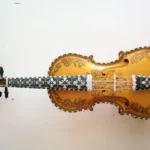
Embarking on a journey through the rich tapestry of Japanese musical heritage, the Shamisen stands as a cultural emblem, resonating with centuries of tradition and innovation. Originating in the 16th century, this three-stringed instrument has gracefully evolved, embracing influences from China and adapting to the diverse musical landscapes of Japan. From its integral role in Kabuki theater to the vibrant contemporary scenes, the Shamisen’s story is one of resilience and adaptation. In this exploration, we unravel 25 historical facts and facets of the Shamisen, delving into its origins, sizes, genres, and even its impact on global culture. Join us in discovering the harmonies, traditions, and modern echoes of this iconic instrument as we traverse the realms of its unique soundscapes.
Origins: The Shamisen’s roots trace back to the 16th century in Okinawa, Japan, where it emerged as a distinct musical instrument. It found its inspiration in the Chinese sanxian, which was introduced to Japan by Chinese traders. Over time, the Shamisen evolved into a unique three-stringed instrument, capturing the essence of Japanese musical tradition.
Three Strings: The name “Shamisen” itself encapsulates a defining feature of the instrument – it translates to “three strings.” This characteristic arrangement contributes to the Shamisen’s distinctive sound and versatility, allowing it to evoke a wide range of emotions and moods in different musical genres.
Development: The Shamisen’s development reflects a fascinating cultural exchange between Japan and China. Initially inspired by the Chinese sanxian, the Shamisen underwent modifications and innovations, becoming an integral part of Japanese musical culture. This fusion of influences highlights the interconnectedness of musical traditions across borders.
Body Structure: The Shamisen’s physical structure is instantly recognizable, featuring a body with a skin-covered resonator and a long neck. The combination of these elements produces a unique timbre, making the Shamisen a standout instrument in the world of traditional Japanese music.
String Materials: Traditionally, Shamisen strings were crafted from silk, emphasizing the instrument’s historical connection to artisanal craftsmanship. While modern versions may incorporate nylon or other materials, the use of silk strings remains a nod to the traditional techniques that have been passed down through generations.
Sizes: The Shamisen comes in various sizes, each associated with specific musical genres. The nagauta, jiuta, and tsugaru are among the most common, with each size tailored to suit the stylistic nuances and performance requirements of different musical traditions.
Genres: The Shamisen’s versatility extends across a spectrum of musical genres, from the dramatic accompaniment in Kabuki theater to the soulful expressions of min’yo folk music. Its adaptability has allowed it to endure through centuries, shaping and being shaped by the diverse musical landscapes it inhabits.
Kabuki Accompaniment: In the Edo period (1603–1868), the Shamisen became an indispensable part of Kabuki theater, providing the melodic and rhythmic foundation for the dramatic performances. Its presence elevated the emotional resonance of Kabuki, creating a symbiotic relationship between the instrument and the theatrical narratives.
Popularization: As centuries passed, the Shamisen transcended its association with aristocracy and found popularity among commoners and geisha. This democratization of the instrument contributed to its cultural significance, making it an accessible and cherished part of everyday life.
Professional Players: Shamisen mastery is a highly regarded skill, and professional players, known as “Shamisenkata” or “Shamisen-shi,” dedicate their lives to honing their craft. These skilled artisans play a pivotal role in preserving the integrity of the Shamisen tradition and ensuring its continued vibrancy in contemporary times.
Bachido: In the contemporary landscape, organizations like Bachido have emerged to promote and preserve the Shamisen tradition. Founded by Kyle Abbott, Bachido serves as a platform for enthusiasts and players to connect, share resources, and advance their skills. The community fosters a sense of camaraderie, creating a bridge between the rich historical roots of the Shamisen and the evolving interests of modern enthusiasts.
Tsugaru-jamisen: A modern style of Shamisen playing, Tsugaru-jamisen, is renowned for its dynamic and percussive techniques. Originating from the Tsugaru region in northern Japan, this style emerged in the late 19th century and gained prominence in the 20th century. Tsugaru-jamisen reflects the evolving nature of Shamisen music, incorporating elements that resonate with contemporary audiences while honoring its traditional essence.
Shamisen Construction: Craftsmanship is a hallmark of the Shamisen’s legacy, with the body often made from cat or dog skin stretched over a wooden frame. The meticulous construction process involves selecting high-quality materials and adhering to time-honored techniques, contributing to the instrument’s resonance and durability.
Resurgence: The Shamisen has experienced a notable resurgence in popularity in contemporary music scenes. Its distinct sound has found a place not only in traditional Japanese music but also in various genres globally. This renewed interest underscores the instrument’s adaptability and enduring appeal across cultural boundaries.
Worldwide Influence: Outside of Japan, artists like the Yoshida Brothers have played a pivotal role in introducing the Shamisen to global audiences. Through collaborations, performances, and recordings, these artists have showcased the instrument’s versatility, fostering an appreciation for Japanese musical traditions on an international scale.
Kinnara and Itsuwa: In ancient Japan, the Shamisen was known by various names, including “Kinnara” and “Itsuwa.” These historical references highlight the instrument’s deep cultural roots and its association with mythical and spiritual elements in Japanese folklore.
Notation System: Shamisen music relies on various notation systems, with kumiuta notation being one of the prominent methods. This system provides a structured way to transcribe musical compositions, ensuring the preservation and transmission of Shamisen pieces from one generation to the next.
Hybrids: In the spirit of innovation, experimental versions of the Shamisen, such as the electric Shamisen, have been created. These hybrids blend traditional craftsmanship with modern technology, expanding the sonic possibilities of the instrument and bridging the gap between classical and contemporary musical expressions.
Silk Industry Impact: The Shamisen’s historical connection to silk strings has had a notable impact on the silk industry in Japan. The demand for high-quality silk for Shamisen strings contributed to the development of sericulture, emphasizing the intricate relationship between traditional crafts and broader economic activities.
Measuring Sound: Traditional methods of measuring Shamisen sound quality often involve units like “sun,” which is based on the width of a bamboo node. This nuanced approach to evaluating the instrument’s acoustics reflects the attention to detail and precision inherent in the world of Shamisen craftsmanship and performance.
Modern Innovations: Contemporary artisans continue to explore modern innovations in Shamisen construction. Experimenting with materials and construction methods, these craftsmen aim to strike a balance between preserving traditional techniques and adapting the instrument to the preferences and demands of a changing musical landscape. This delicate dance between tradition and innovation ensures the Shamisen’s relevance in evolving artistic expressions.
1920s Recordings: The 1920s marked a significant era for the Shamisen as it witnessed the first commercial recordings of Shamisen music. This technological leap allowed the intricate sounds of the Shamisen to be captured and shared beyond live performances, contributing to the broader dissemination of Japanese musical traditions.
Nagauta Style: Within the realm of Kabuki Shamisen music, the Nagauta style stands out as one of the most prominent. Originating in the Edo period, Nagauta compositions are characterized by their melodic and rhythmic intricacies, providing a captivating backdrop to Kabuki theater performances. The Nagauta style showcases the Shamisen’s ability to convey the emotional depth required in dramatic storytelling.
Popular Culture: The Shamisen has woven itself into the fabric of popular culture, making appearances in various films, anime, and J-pop music videos. Its distinctive sound often serves as a cultural identifier, enriching visual and auditory experiences and further solidifying its role as an iconic symbol in both traditional and contemporary Japanese contexts.
Revival in Education: Efforts to preserve Shamisen traditions extend to educational programs and workshops aimed at passing on the art to new generations. Schools, both in Japan and internationally, offer classes where aspiring players can learn the techniques, history, and cultural significance of the Shamisen. This commitment to education ensures that the legacy of the Shamisen continues to thrive, fostering a continuum of appreciation for this ancient musical treasure.









